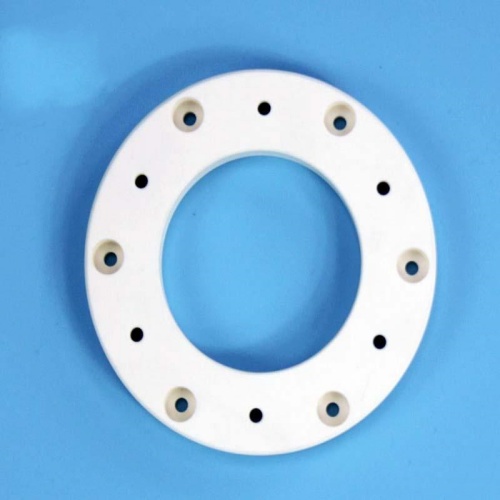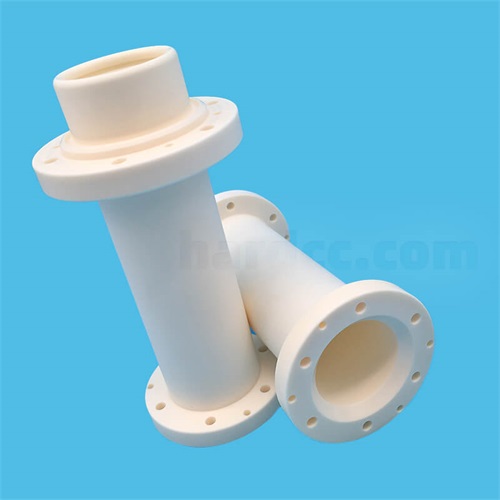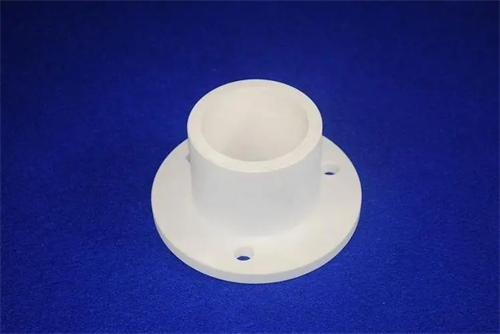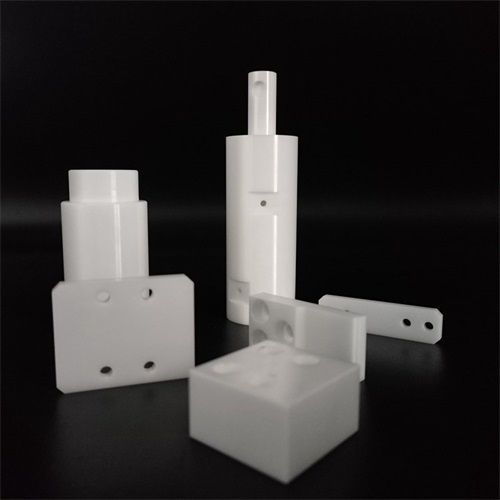The advantages of alumina ceramic flanges
As a high-performance industrial connection component, alumina ceramic flanges have shown significant advantages in many industrial fields due to their unique physical, chemical and mechanical properties, and have gradually become an ideal substitute for traditional metal flanges.
Excellent wear resistance
The hardness of alumina ceramics is extremely high, with Mohs hardness reaching 9, second only to diamond. This high hardness gives alumina ceramic flanges extremely strong wear resistance, enabling them to maintain stable performance for a long time in high wear environments. For example, in conveyor systems in mining, metallurgy, power generation and other industries, the service life of alumina ceramic flanges is 5-10 times that of traditional metal flanges. This wear resistance not only reduces the maintenance frequency of equipment, but also significantly reduces the risk of leakage due to wear, improving the reliability and operating efficiency of the system.
Excellent high temperature resistance
Alumina ceramic flanges can remain stable in extremely high temperature environments, with a maximum operating temperature of 1600 ° C. This high temperature resistance makes them excellent in high temperature applications such as high temperature furnaces, heat treatment equipment, aerospace engines, etc. Compared with traditional metal materials, alumina ceramics do not creep or deform at high temperatures, which can effectively avoid equipment failure due to material failure.

Excellent corrosion resistance
Alumina ceramics have extremely high corrosion resistance to most acids, alkalis, salts and other chemical media. In the chemical, pharmaceutical, food and other industries, alumina ceramic flanges can resist the erosion of various corrosive media and maintain the integrity and performance of the material. This corrosion resistance not only extends the service life of the flange, but also reduces the risk of chemical media leakage and improves the safety of the system.
Excellent electrical insulation properties
Alumina ceramics have an extremely high resistivity (> 10 ² Ω · cm) and are an excellent electrical insulating material. In electronic and electrical equipment, alumina ceramic flanges can effectively prevent current leakage and reduce the risk of electrochemical corrosion. This insulating property makes it an ideal material for manufacturing electronic components such as high-voltage insulators and integrated circuit substrates.

High mechanical strength and low coefficient of thermal expansion
The compressive strength of the alumina ceramic flange is up to 2000 MPa, which can withstand high pressure and high load. At the same time, its thermal expansion coefficient is low (about 7 × 10/℃), and it has good dimensional stability in high temperature environments, and is not prone to thermal expansion and contraction. This characteristic allows it to maintain stable connection performance under complex working conditions of high temperature and high pressure.
Good sealing performance
The surface of the alumina ceramic flange is smooth and dense, which can effectively prevent the leakage of the medium. Its precise processing technology ensures that the sealing surface of the flange has high precision, and with high-quality sealing gaskets, it can achieve a reliable sealing effect. This good sealing performance is particularly important in the fluid transportation system of the chemical, oil, natural gas and other industries, which can effectively reduce the occurrence of leakage accidents.

Environmental protection and sustainability
The production process of alumina ceramics is relatively environmentally friendly. Its main raw material alumina powder is widely sourced, and the energy consumption of the sintering process is low. In addition, waste alumina ceramics can be recycled and reused, avoiding environmental pollution caused by waste metal materials. In the context of increasingly strict environmental protection policies, the environmental advantages of alumina ceramic flanges make them an ideal choice for enterprises.
Economic and cost-effective
Although the initial procurement cost of alumina ceramic flanges may be higher than that of traditional metal flanges, their long life and low maintenance characteristics can significantly reduce the total life cycle cost. For example, in some industrial applications, the use of alumina ceramic flanges has reduced equipment maintenance costs by 40% and increased production efficiency by 25%. In addition, its energy-saving and consumption-reducing characteristics can also bring additional economic benefits to the enterprise.

Customization and processing flexibility
Alumina ceramic flanges can be customized according to different industrial needs and can be processed into a variety of complex shapes and sizes. Through advanced processes such as dry pressing, injection molding, 3D printing, etc., high-precision processing can be achieved to meet the strict requirements of high-end fields such as semiconductors and medical devices. This customization capability allows alumina ceramic flanges to better adapt to various complex industrial scenarios.
Wide range of application fields
Alumina ceramic flanges have been widely used in many fields such as aerospace, electronic power, chemical metallurgy, food and pharmaceutical because of their excellent performance. For example, in the aerospace field, alumina ceramic flanges are used in engine components and high temperature structural parts; in the electronic power field, high voltage insulators and integrated circuit substrates; in the chemical metallurgy field, reaction vessels and high temperature furnace components. Its wide range of application scenarios proves the versatility and adaptability of alumina ceramic flanges.
Alumina ceramic flanges have shown great advantages in many industrial fields due to their excellent wear resistance, high temperature resistance, corrosion resistance, electrical insulation, high mechanical strength, low thermal expansion coefficient, good sealing performance, environmental protection, economy and customization capabilities.
PREVIOUS:How do ceramic flanges perform in extreme temperatures
CATEGORIES
LATEST NEWS
- What are the applications o...
- What are the uses of silico...
- What are the uses of zircon...
- What are the advantages and...
- What are the advantages of ...
- What are the difficulties i...
- What are the advantages of ...
- The manufacturing method of...
- Application scope of zircon...
- What are the difficulties i...
